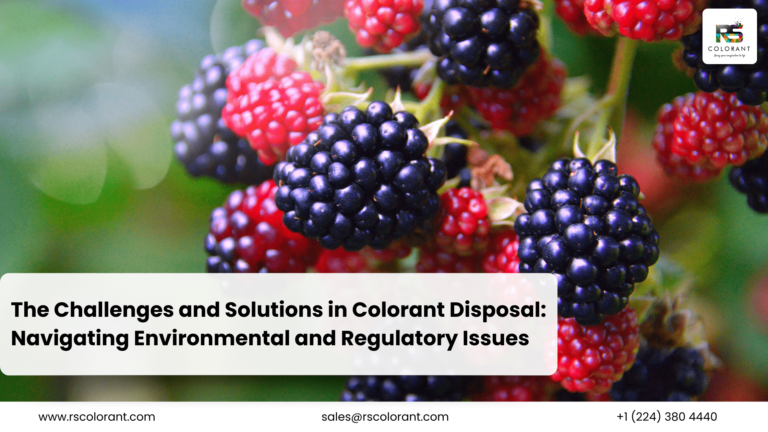Outline
- Introduction
- Overview of colorants
- Importance of government regulations
- Purpose of the article
- History of Colorants Regulation
- Early uses of colorants
- Initial regulatory measures
- Evolution of regulations over time
- Types of Colorants
- Natural colorants
- Synthetic colorants
- Regulatory differences between natural and synthetic colorants
- Key Regulatory Bodies
- Food and Drug Administration (FDA)
- European Food Safety Authority (EFSA)
- Other international regulatory bodies
- Regulations in the Food Industry
- FDA regulations on food colorants
- EFSA regulations on food colorants
- Case studies on food colorant regulations
- Regulations in the Cosmetics Industry
- Safety and compliance standards
- Approved and prohibited colorants
- Impact on product formulation and marketing
- Regulations in the Pharmaceutical Industry
- Colorants in medication and their purposes
- Regulatory requirements for pharmaceuticals
- Ensuring safety and efficacy
- Environmental Regulations
- Impact of colorants on the environment
- Waste management and disposal regulations
- Sustainable practices and compliance
- Health and Safety Concerns
- Potential health risks of colorants
- Regulatory measures to mitigate risks
- Public awareness and education
- Economic Impact of Regulations
- Costs associated with compliance
- Impact on small businesses vs. large corporations
- Market dynamics and consumer prices
- Global Differences in Regulations
- Comparative analysis of regulations across different countries
- Challenges in international trade
- Harmonization efforts and their effectiveness
- Innovation and Regulations
- Encouraging safe innovation in colorants
- Balancing regulation with technological advancement
- Case studies on innovative colorants and regulatory hurdles
- Case Studies of Regulatory Impact
- Specific examples of regulations affecting colorant use
- Analysis of regulatory success stories and failures
- Future Trends in Colorant Regulations
- Emerging trends and potential future regulations
- The role of scientific research in shaping regulations
- Predictions for the next decade
- Conclusion
- Summary of key points
- The importance of balanced regulation
- Final thoughts on the future of colorant regulation
- FAQs
- What are colorants?
- Why are colorant regulations important?
- How do regulations differ between countries?
- What are the health risks associated with colorants?
- How can consumers stay informed about colorant safety?
The Impact of Government Regulations on the Use of Colorants
Introduction
Colorants are everywhere, from the vibrant hues in our favorite candies to the shades in our cosmetics. But have you ever wondered who ensures these colors are safe for us and the environment? Government regulations play a crucial role in this. This article delves into the impact of these regulations on the use of colorants, spanning various industries and geographic regions.
History of Colorants Regulation
Colorants have been used since ancient times, with early civilizations utilizing natural dyes from plants and minerals. As industrialization progressed, synthetic colorants were developed, raising safety concerns. Initial regulatory measures aimed to prevent harmful substances from entering the market. Over time, these regulations evolved, becoming more sophisticated and comprehensive to address emerging challenges.
Types of Colorants
Colorants can be broadly categorized into natural and synthetic types. Natural colorants, derived from plants, minerals, or animals, are often perceived as safer but come with their own set of challenges. Synthetic colorants, created through chemical processes, offer a broader range of colors and stability but are subject to stricter regulations due to potential health risks.
Key Regulatory Bodies
Several regulatory bodies oversee the safety and use of colorants globally:
- Food and Drug Administration (FDA): Governs the use of colorants in the United States, particularly in food, drugs, and cosmetics.
- European Food Safety Authority (EFSA): Regulates food colorants within the European Union.
- Other International Regulatory Bodies: Countries like Japan, Canada, and Australia have their own regulatory frameworks, ensuring local compliance.
Regulations in the Food Industry
Food colorants are subject to rigorous scrutiny. In the US, the FDA mandates that all color additives used in food must be approved for safety. The EFSA in Europe has similar stringent regulations, evaluating colorants for potential risks before approval. Case studies, such as the banning of certain artificial dyes due to health concerns, highlight the dynamic nature of these regulations.
Regulations in the Cosmetics Industry
Cosmetics regulations ensure that products are safe for application on skin, hair, and nails. The FDA maintains a list of approved colorants and prohibits those that pose health risks. In the EU, regulations are even stricter, often banning substances approved elsewhere. This impacts product formulation and marketing, as companies must navigate these regulations to launch products globally.
Regulations in the Pharmaceutical Industry
Colorants in pharmaceuticals serve purposes beyond aesthetics, such as identifying medication types. Regulatory requirements ensure these colorants do not interfere with the drug’s efficacy or safety. The FDA and other bodies evaluate these additives thoroughly, ensuring they meet safety standards.
Environmental Regulations
The impact of colorants extends to the environment. Regulations govern the disposal and management of waste from colorant production and use. Sustainable practices are encouraged, with companies required to adhere to environmental standards to minimize pollution and ecological harm.
Health and Safety Concerns
Colorants can pose health risks, such as allergies or toxicity. Regulatory measures are designed to mitigate these risks through rigorous testing and evaluation. Public awareness campaigns also play a role, educating consumers on safe colorant use.
Economic Impact of Regulations
Compliance with colorant regulations can be costly. Small businesses often face greater challenges compared to large corporations due to limited resources. However, these regulations are essential for market stability and consumer trust, ultimately influencing product prices and market dynamics.
Global Differences in Regulations
Regulatory frameworks vary significantly across countries, posing challenges for international trade. A comparative analysis reveals differences in safety standards and approved substances. Efforts to harmonize these regulations aim to simplify trade and ensure global safety standards.
Innovation and Regulations
Innovation in colorant technology is crucial, but it must balance safety with advancement. Regulatory bodies encourage safe innovation, though navigating regulatory hurdles can be challenging. Case studies of innovative colorants show how companies overcome these challenges to bring new products to market.
Case Studies of Regulatory Impact
Examining specific examples of how regulations affect colorant use provides insights into their effectiveness. Success stories and failures highlight the complexities of creating and enforcing regulations that protect public health without stifling innovation.
Future Trends in Colorant Regulations
Emerging trends suggest that future regulations will become even more stringent, driven by scientific research and public demand for safety. Anticipating these changes can help industries prepare and adapt, ensuring continued compliance and innovation.
Conclusion
Government regulations on colorants are vital for ensuring public health and safety. While they pose challenges, especially for small businesses, their benefits far outweigh the costs. As we look to the future, balanced and well-informed regulations will continue to protect consumers and foster innovation in the colorant industry.
FAQs
What are colorants? Colorants are substances used to impart color to various products, including food, cosmetics, and pharmaceuticals.
Why are colorant regulations important? Regulations ensure that colorants are safe for human use and the environment, preventing potential health risks and ecological damage.
How do regulations differ between countries? Different countries have varying safety standards and approved substances, reflecting local health priorities and regulatory frameworks.
What are the health risks associated with colorants? Potential risks include allergies, toxicity, and long-term health effects, which regulations aim to mitigate through rigorous testing and approval processes.
How can consumers stay informed about colorant safety? Consumers can stay informed by reading product labels, researching regulatory approvals, and following public health advisories on safe colorant use.




